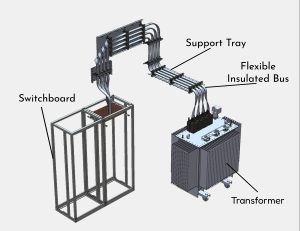How are Flexible Bus Systems (FBS) installed according to the NEC 2023?
Overview
The flexibility and high amperage capacity of Flexible Bus Systems (FBS) enable their versatile use in various applications and power system equipment designs. However, specific installation procedures are necessary for each application to mitigate unique stresses that could potentially damage the FBS. Given that FBS is a relatively recent innovation, standardized usage and installation practices were lacking prior to NEC 2023. To address this, NEC Section 371.18 has been introduced to establish standardized installation guidelines for flexible bus systems.
each application to mitigate unique stresses that could potentially damage the FBS. Given that FBS is a relatively recent innovation, standardized usage and installation practices were lacking prior to NEC 2023. To address this, NEC Section 371.18 has been introduced to establish standardized installation guidelines for flexible bus systems.
Applying the 2023 Code
Traditionally, power equipment has managed electricity multiplexing and demultiplexing using a combination of bus bars and conductors/cables. This rigid structure required precise alignment to maintain isolation between phases and conductors, hindering engineers from constructing physically durable, high-current connections between devices like transformers and switchboards. Flexible Bus Systems (FBS) have recently entered the power industry to address these challenges. FBS not only offer the flexibility to accommodate sharp turns but also maintain sufficient rigidity in the central conductor/bus bar to handle high amperage. The introduction of FBS enables the design of compact, high-capacity systems and smaller devices such as transformers, switchboards, and switchgears. However, being a relatively new innovation, FBS lacked standardized installation practices in previous editions of the NEC. To address this, the NEC 2023 edition has introduced Section 371.18, defining the usage and installation requirements of FBS and associated fittings. These standardized practices will facilitate the development of a uniform approach to FBS usage and installation procedures within the industry.
What’s New for the 2023 NEC?
2020 NEC
In the 2020 NEC, no reference can be found regarding Flexible Bus Systems (FBS) due to their recent introduction to the industry.
2023 NEC
In the 2023 NEC, Section 371.18 has been introduced to standardize the usage and installation procedures for flexible bus systems. The new Section now reads as follows:
371.18 Flexible Bus Systems Installation
Installation of flexible bus systems shall comply with 371.18(A) through (E).
(A) Manufacturer’s Installation Instructions
Flexible bus systems shall be installed under design engineering supervision and in accordance with the manufacturer’s instructions, including supporting and securing. All documentation shall be available to the authority having jurisdiction.
(B) Physical Damage
Flexible bus systems subject to physical damage shall have approved protective means installed.
Informational Note: Typical methods of protecting flexible bus systems from physical damage include suitable barriers, guards, or elevation.
(C) Transversely Routed
Flexible bus systems shall be permitted to extend transversely through partitions or walls if the section within the wall is continuous and protected against physical damage. Where the flexible bus systems penetrate a fire-resistant-rated wall or partition, the installation shall be made in accordance with 300.21.
(D) Through Dry Floors and Platforms
Flexible bus systems shall be permitted to extend vertically through dry floors and platforms. Where the flexible bus systems penetrate a fire-resistant-rated floor or ceiling, the installation shall be made in accordance with 300.21.
(E) Through Floors and Platforms in Wet Locations
Flexible bus systems shall be permitted to extend vertically through floors and platforms in wet locations as follows:
1.Where there are curbs or other suitable means to prevent waterflow through the floor or platform opening
- Where the flexible bus system provides a means to seal the floor penetration
Where the flexible bus systems penetrate a fire-resistant-rated floor or ceiling, the installation shall be made in accordance with 300.21.
